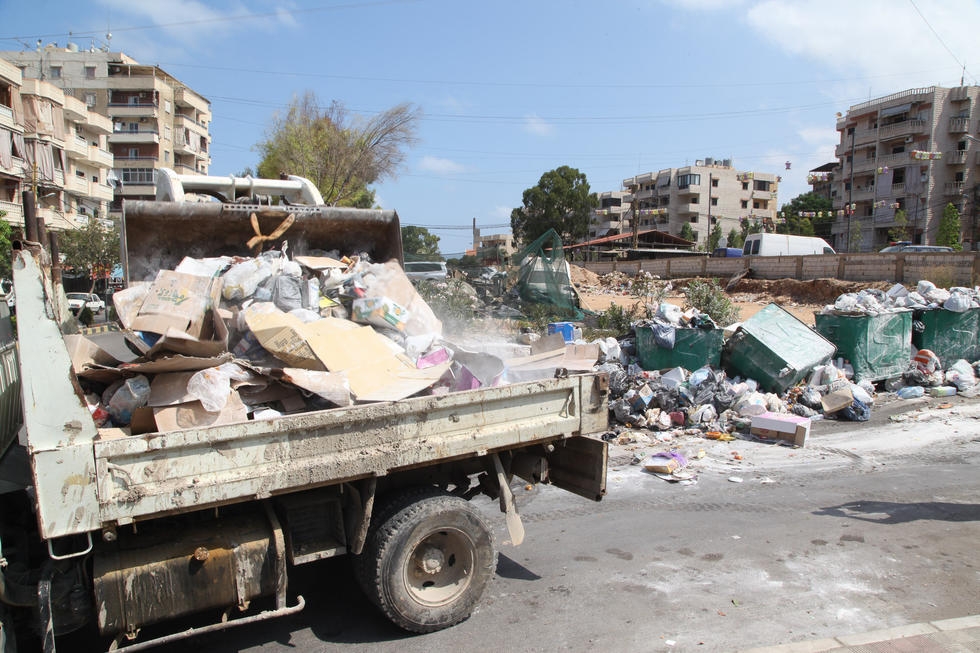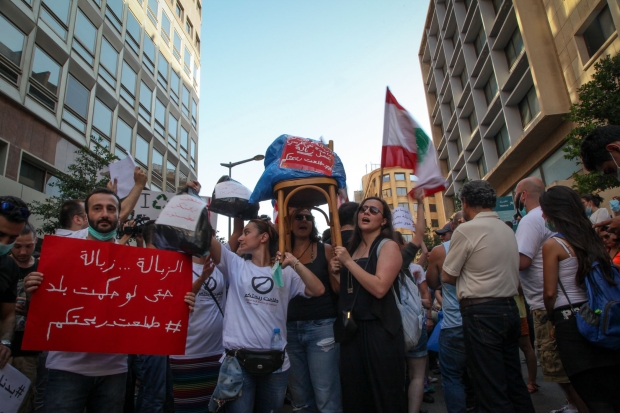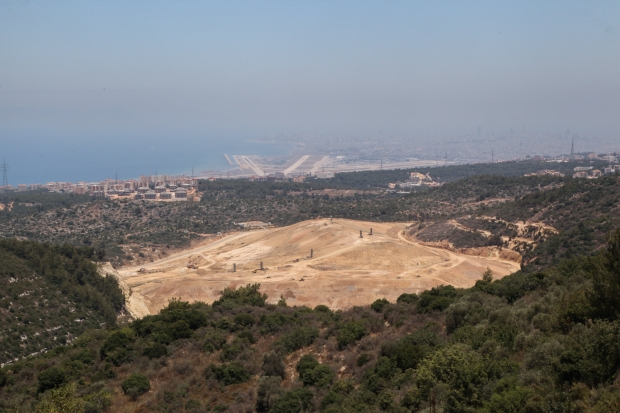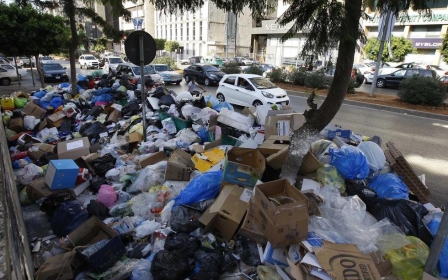Lebanon’s rubbish crisis, 40 years in the making

BEIRUT – After weeks of scrambling, Lebanon’s Prime Minister Tammam Salam on Wednesday promised that the country would see a “phased” end to its mounting garbage crisis, which could be over “within days”.
But more than 21 days after rubbish collection in the capital first stopped and piles of rotting waste began decomposing in the city’s streets in the summer heat, many residents are demanding an overhaul of the situation, not another quick fix.
This frustration was evident last week. Even as the government announced its plan to deal with the problem, hundreds of people took to the streets of downtown Beirut to call for a “revolution” in rubbish removal.
Government promises on 24 July to get the garbage flowing into new landfill sites has likewise proven insufficient, especially for those who object to simply burying the garbage.
“No landfill, no dump sites, no incinerators,” said Ajwad Ayash, an activist with the Association to Close Naameh Landfill, a local campaign group. “We need the three Rs – reduce, reuse, recycle.”
This, however, was not part of the government’s emergency plan. Instead, the authorities have opted to build more landfill sites and establish incinerators to burn much of the trash - a solution civil society groups, activists and residents are loathed to swallow.
While all agree that Lebanon’s waste system needs a comprehensive, modern overhaul - without which the country is likely to keep lurching from one disaster to another - decades of poor planning and previous failures mean that the problem is much more deeply rooted than the latest crisis suggests.
A crisis founded in war
The most recent garbage stand off is only the latest in a long line of infrastructural and governance issues that stretch back to the 15-year civil war and have left different parts of the country drowning in their own filth.
Much of the country’s infrastructure was ravaged during the conflict in the small, but religiously diverse, Mediterranean country that was effectively split into warring cantons. The national government – national in name only – was unable to provide even the most basic services uniformly, leaving many areas to fend for themselves with vastly different consequences.
Paul Makhoul, 50, lived between the southern port city of Sidon and Beirut during the war and says that the recent crisis reminds him of those harsh times.
“There was no collection in the south. In the villages, every two to three houses would get together and dig a hole in the ground and burn their trash there,” Makhoul said.
“Burning for many was the only option: We would do it when the wind was facing away from the houses, so that they wouldn't get the smell.”
However, not all were equally as hard-hit. Yvette Ghazi, 83, who lived in Christian majority Kesrouan, north of Beirut, told Middle East Eye that even during the height of the war, the rubbish situation never spiralled out of control.
According to her, things are now worse than ever.
“We didn't have a problem like this during the war. We would throw out our trash as usual and the municipality would pick it up but we never knew where they were taking it,” Ghazi said.
“The Kataeb and the Lebanese Forces [two Christian majority paramilitary groups that later became political parties] had everything organised in those areas.”
Much more than household waste
While household waste seems like the most obvious issue for many, it is only one part of the problem. There is now growing evidence that over the years dangerous hospital and chemical waste have been discarded into public dumpsites as well as makeshift illegal ones.
There are an untold number of these potentially hazardous sites buried throughout the country.
Reports again go back to the war. In one particularly controversial incident in 1987, when the fighting was at its fiercest, it is alleged that Lebanese Forces (LF) militia took $22mn from the Italian mafia to dispose of 15,800 barrels and 20 containers of toxic waste in the Lebanese hills.
The health minister at the time gathered experts to investigate the claims and found evidence that much of the toxic waste had been burned or bumped in public waste sites to fester for years to come.
But attempts to bring the perpetrators to justice came to nothing. The charges against the LF members involved in the scandal were dropped following a blanket amnesty for the country’s various armed groups passed as part of the post-war negotiations in 1992.
Failed post-war reconstruction
After the war, a "national strategy" was put in place to deal with waste management, but problems were apparent from the start.
It was never really a “national” strategy, explained Ziad Abichaker, founder of Cedar Environmental, an environmental research and development facility in Lebanon.
Instead, Abichaker believes the strategy was only ever designed with Beirut and Mount Lebanon - the two most populous areas of the country - in mind. This left the south, the Bekaa Valley and the north out of the equation.
The national strategy left approximately 50 percent of the country’s waste going to a single landfill site at Naameh, 30 minutes south of Beirut. On top of this, there was very little, if any, sorting and splitting of waste and the process of identifying and building new sites for landfill moved slowly.
According to Rizkallah, the Environment Ministry has drafted many national frameworks and even submitted legislation concerning the management of solid waste - the first step to reforming the national strategy - to parliament in 2012, but no progress has been made. Political deadlocks have held up almost all legislation and MPs have barely held a session in the last year.
The roots of the failure to implement a proper strategy undoubtedly lie in the complex, convoluted post-war politics of Lebanon.
'Trash Mountain' transformation
While international headlines are focusing on Beirut’s problems, the southern port city of Sidon has probably born the brunt of the country’s inept management.
The city became infamous in the 1990s for its 58-metre high “Trash Mountain” - an enormous dump in a coastal valley near the city, which on some days could be smelt in the city and on the coastal road kilometres away.
“There was some kind of political agreement that started the mountain of trash,” Makhoul said. “When the sea would come up, it would take the trash with it out to the Mediterranean. And during the summer, you couldn't even go to Sidon because of the garbage smell.”
The mountain was a major eyesore and a danger - waste from the site was known to wash up in Cyprus 260km away during storms and fires were a common occurrence. The site was a mix of household and general rubbish but an estimated 60 percent of the sites was found to be rubble from buildings destroyed during the war. The noxious gases released from the site would settle over the city for days at a time. Local residence all talked of their shame and anger at the site, which sat on the edge of their city.
However, Sidon has become a rare garbage success story in Lebanon. The trash mountain has been transformed from rubbish dump to 100,000 square foot Public Park, complete with olive trees and an amphitheatre, in a project overseen by the United Nations Development Programme.
Much of the building rubble and dangerous waste was removed and processed, leaving only non-hazardous household trash. Pipes running through the site filter the gas and effluent waste. The smell has gone and the city has gained a new public space. Many are calling this success a blueprint for other dump sites around the country, despite the $25 million price tag.
Both Rizkallah and Abichaker say that localised municipal governments must be empowered to help end the decades of deadlock.
“The major obstacle now is the monopolistic behaviour of central government who are centralising the issue into the pockets of a few people,” said Abichaker. “They can keep control through legislation but they have to let go of the money [to municipalities].”
Size matters
Space is another issue further complicating matters. As a small country, about the size of Wales, it is hard to find appropriate landfill sites that are not near sizable population centres.
Ayash says that around 100,000 people live within 10km of the Naameh landfill site. While there is some debate internationally about the effects of living near landfill sites, a Lebanese Ministry of Health report was recently undertaken to assess the impact of the site.
The report has not been released publicly and its author has refused to speak to the press, however activists who have seen the study said it is troubling. It reportedly found significantly higher rates of cancer and respiratory problems in those living near the site than the national average, suggesting some correlation with the landfill site. However this cannot be independently verified without a copy of the study.
On top of this, land prices have increased dramatically in recent years making landfill an increasingly expensive solution for an already financially stretched country.
Reconstruction and development have been further hampered by war. The 33-day war with Israeli in 2006 once again ravaged the country and its coffers. The direct structural damage to Lebanon was estimated at $3.6bn.
Maliban, the country’s only glass recycling plant - which had been processing all the country’s green, amber and clear glass – was levelled and never rebuilt.
Only one small facility in the north of the country has risen up with the capacity to recycle clear glass, but an estimated 71 million bottles a year are being thrown away in Lebanon, said Abichaker.
Green Glass Recycling Initiative in Lebanon (GGRIL), Abichaker’s corporate social responsibility project, has started running a green glass recycling project. The group now recycles 200-300 tons of glass a year (about 650,000 green bottles) but admits much more needs to be done.
Given the huge gap in recycling capacity, even some activists admit that at least in the medium term Lebanon has to be more pragmatic.
“Recycling is part of the solution but it is not a cure,” Rizkallah said. “If a programme is done really well maybe 40-50 percent of waste is recycled but there still needs to be landfill or incineration, or both.”
Rizkallah explains that he is not entirely pessimistic about a good solution coming out of this and sees the most recent crisis as a turning point for waste disposal and management.
“The level of awareness that this has brought in just a few days is the same as hundreds of thousands of dollars of campaigning,” he said.
He explains that he hopes this new level of support, coupled with the understanding of what happens when the issue of rubbish is not tackled head on will finally force a more long-term solution.
New MEE newsletter: Jerusalem Dispatch
Sign up to get the latest insights and analysis on Israel-Palestine, alongside Turkey Unpacked and other MEE newsletters
Middle East Eye delivers independent and unrivalled coverage and analysis of the Middle East, North Africa and beyond. To learn more about republishing this content and the associated fees, please fill out this form. More about MEE can be found here.






